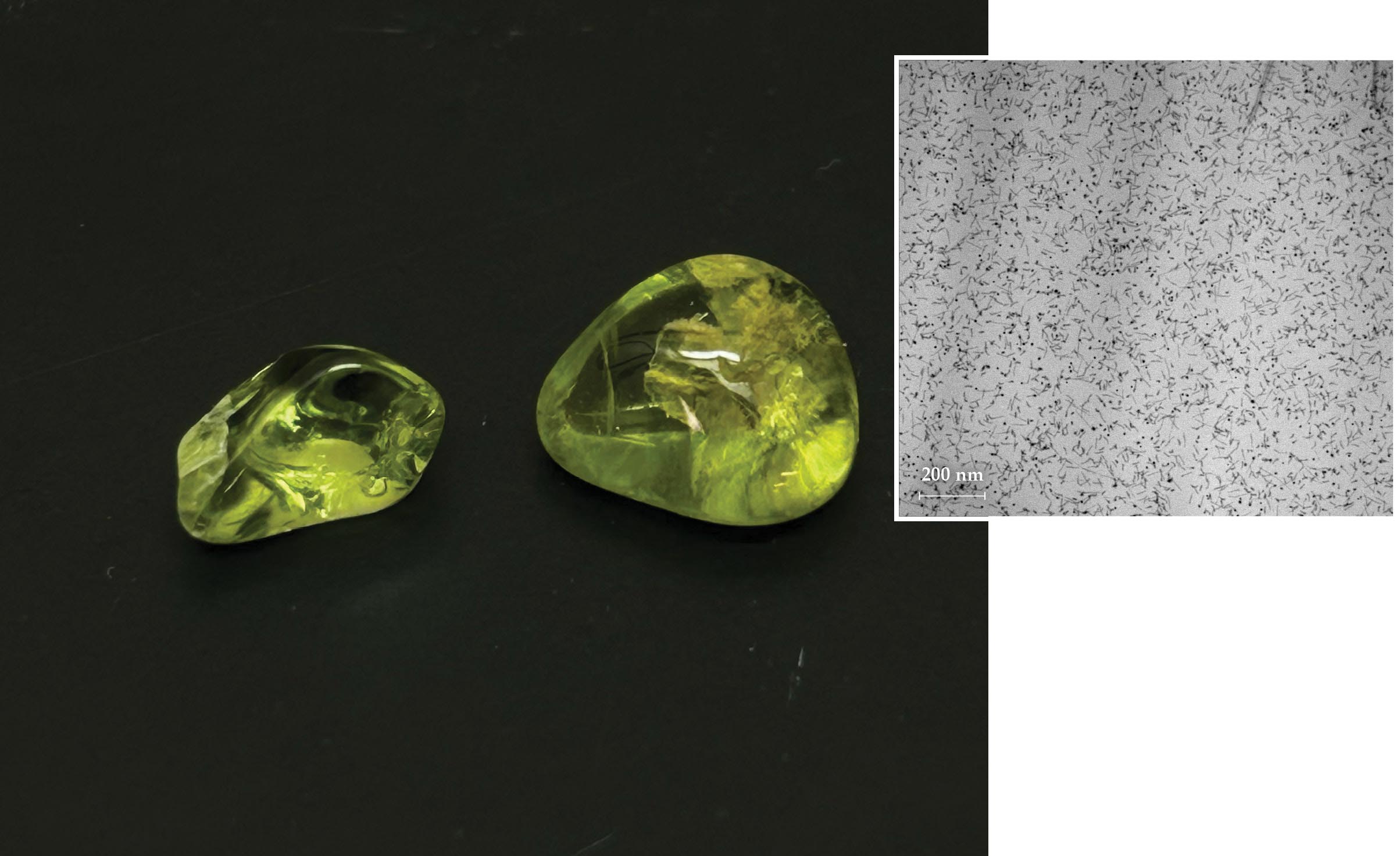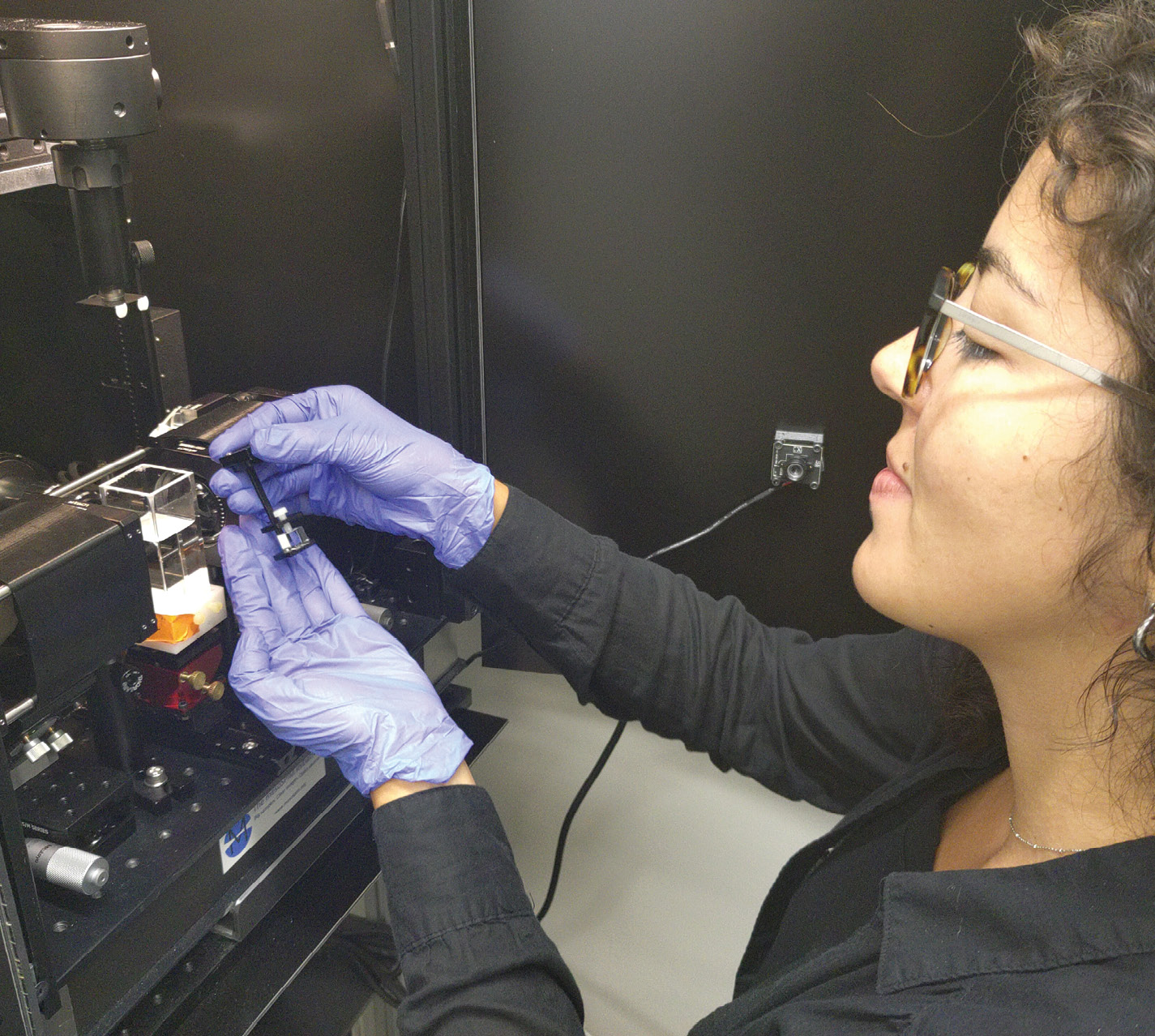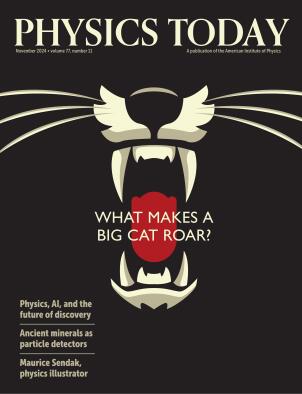Search amps up for signatures of cosmic particles in ancient minerals
DOI: 10.1063/pt.xutj.iblb
What if a mineral could reveal what it’s seen over the millions—or billions—of years it’s been sitting deep within Earth? An interdisciplinary global network of scientists is reviving efforts to unlock the secrets that minerals hold. The top goals are to identify dark matter, learn more about neutrinos, and use both as cosmological probes.
Over epochs, even a tiny grain of sand would be exposed to an enormous flux of neutrinos and dark matter. Using such samples trades mass for time: A 1 g, billion-year-old mineral offers the same total exposure as a 1000-metric-ton target mass over one year; for the same exposure, the LUX-ZEPLIN experiment at the Sanford Underground Research Facility in South Dakota, with its 5.5 metric tons of liquid xenon, would have to hunt for dark matter particles for 182 years. And whereas giant conventional detectors provide a snapshot from the period of observation, minerals harbor data spanning the history of their existence.
The idea of using minerals to look for fossils of cosmic interactions is not new. In the 1980s and 1990s, a few researchers used mica to search for evidence of exotic particles and dark matter. Such paleo-detection efforts stalled because neither imaging nor data handling was up to the task. At the same time, the enormous liquid and solid-state detectors that have since become the norm were gaining momentum.
But thanks to advances in imaging, data storage, computation, and machine learning, a smattering of researchers are looking anew at paleo-detection. They are motivated by the limitation of multiton detectors, which cannot be significantly scaled up; the allure of obtaining historical data; and the continued elusiveness of dark matter.
Chris Kelso, a theoretical physicist at the University of North Florida, suggests that looking at the rate of supernova explosions over time is doable in the next five or so years. “We understand the neutrino physics pretty well,” he says. “That’s an advantage of paleo-detectors—we know there is a signal, so I think we can do this.”
Damage tracks
Most approaches to using minerals as paleo-detectors would look at the tracks caused by recoil: When an incident particle hits a nucleus in the mineral, the impacted nucleus is knocked out, leaving a hole and dislodging or disturbing other lattice atoms, thereby creating a trail. “Chemical bonds will be broken and atoms will be displaced,” says Patrick Huber, a theoretical physicist at Virginia Tech and director of its Center for Neutrino Physics. “Some of those changes will be permanent.”

Tracks in olivine (right) left by incident gold ions and their targets mimic those calculated to be induced by atmospheric neutrinos. The tracks were imaged with scanning tunneling electron microscopy. The ions were shot perpendicular to the image, so the tracks appear shorter than they are. At left are small olivine crystals.
KAI SUN/EMILIE LAVOIE-INGRAM

Damage tracks have been used on larger scales for more than a half century to date rocks: When uranium-238 fissions, the products interact with lattice elements and leave tracks typically up to 20 µm in length. The rock’s age can be determined from the ratio of the number of fission tracks to the total number of 238U atoms—obtainable by various methods—in the volume.
Although neutrinos seldom interact with matter, now and then one hits a nucleus and gives it a kick. Dark-matter mineral searches would similarly involve analyzing damage trails. Theoretical physicists calculate that the weaker impulses of dark matter and low-energy neutrinos—inducing nuclear recoils in the range of 0.1–100 keV, compared with the tens of millions of electron volts in fission track dating—would lead to tracks that are nanometers to hundreds of nanometers in length.
“You model sources of recoil,” says Patrick Stengel, a postdoc at the Jožef Stefan Institute in Ljubljana, Slovenia, and one of the theoretical physicists credited with reigniting interest in mining minerals for data. “You wind up with spectra of track lengths, which tell you something about the energy of the incident particles.” Through statistical analyses of damage tracks, he says, it should be possible to differentiate among the spectra to identify impinging particles.
Experiments so far have mostly been controls to gear up for analyzing ancient minerals. Shigenobu Hirose is an experimental physicist at the Japan Agency for Marine-Earth Science and Technology. To simulate the 10–100 keV recoils that dark matter would produce, he shoots fast neutrons at processed mica in which tracks have been erased with heat. He then chemically etches the sample to enhance the tracks and render them into pits that are measurable with an optical profiler. “The higher the recoil energy, the deeper the pits,” he says.
Hirose has begun searching for evidence of dark matter in ancient mica from a mine in Bihar, India. “We may get some information about dark matter, like the mass and cross section,” he says. “Even if we don’t find dark matter, we can set limits on those characteristics.”
Joshua Spitz, an experimental particle and astroparticle physicist at the University of Michigan, is preparing to search for tracks from atmospheric neutrinos. They are produced from interactions of cosmic rays with molecules in Earth’s atmosphere. Tracks from the neutrinos “are surely below our feet,” says Spitz. Atmospheric neutrinos “are low-hanging fruit because they create long tracks, up to hundreds of microns in length.”
Spitz aims to look at rocks from different places, date them from fission tracks, and plot the atmospheric neutrino rate over time. The solar system orbits the galaxy center roughly every 230 million years. “If you get a billion-year-old rock and others of varying ages, you can probe the cosmic-ray history of Earth over four revolutions,” says Spitz. The same can, in principle, be done with dark matter, neutrinos from supernovae, and other cosmic particles.
To get started, Spitz and his group are creating and characterizing tracks in olivine. They shoot gold ions into a sample as a proxy for nuclei recoiling from incident atmospheric neutrinos. The subangstrom resolution of scanning tunneling electron microscopy permits measurement of track width, length, and shape. But it’s a 2D probe. To get 3D information, says Spitz, “you have to cut, polish, and scan layers that are about 200 nm thick. It’s laborious.”
This fall, his university is getting an x-ray machine that will have 17 nm voxel resolution. With that, he says, he will use olivine pebbles up to 0.1 g in size. A 0.1 g, billion-year-old sample is expected to contain about 300 tracks in about 1016 mostly empty voxels, he says. “It gets to be overwhelming. You have to store and figure out how to handle the data.”
Gabriela Araujo, a postdoctoral researcher at the University of Zurich, is conducting experiments with light-sheet optical fluorescence microscopy. She uses transparent minerals that have been irradiated to form defects, so-called color centers: If an unpaired electron moves into a vacancy created by a recoiling nucleus, she explains, it can absorb and emit light, rendering it fluorescent and thus making the tiny defect visible in optical wavelengths.
The light-sheet microscope shines a 3-μm-thick plane of laser light, causing the defects to fluoresce. The crystal is then moved in steps to create a 3D rendering. A centimeter-size sample can be imaged in minutes, says Araujo. For now, she is using “mimic signals” made with gamma rays, alpha particles, and neutrons in different crystals to gain an understanding of a full range of signals.
Huber’s group at Virginia Tech works with Araujo, doing much of the sample irradiation and characterization. In a couple of years, he says, “we should be able to understand reactor neutrinos.” His immediate aim is to apply the principles of paleo-detection to nuclear safeguarding: “You could place a clean crystal the size of a Hershey’s bar near a nuclear power reactor and come back in three months to change out the bar,” says Huber. “The data should agree with the declared use of the reactor.”
Mine, image, analyze
Over the past couple of years, the various research groups working in areas related to paleo-detection have come together. Stengel launched an annual workshop, whose first meeting last year in Trieste, Italy, attracted geoscientists, material scientists, and theoretical and experimental physicists from Europe, Japan, and the US. Many of the attendees are now collaborating, and some have recently won grants to work in paleo-detection: Spitz was awarded $1.25 million over five years from the Gordon and Betty Moore Foundation, and a multi-institutional team led by Huber has $3.5 million over five years from NSF.
Katherine Freese, director of the Weinberg Institute for Theoretical Physics at the University of Texas at Austin, was involved in the research in the 1980s that spurred the hunt for dark matter and was also part of the team that recently jump-started paleo-detection. “It’s really exciting,” she says. “We have all these people from all over the world and from all different fields. You learn all kinds of things—for instance, minerals from Europe are no good for paleo-detection, the earth has moved too much. Minerals from the Americas can be useful.”

Gabriela Araujo loads a crystal into a light-sheet fluorescent microscope to create a 3D image of defects. She is studying tracks from known sources to facilitate analysis of ancient minerals. During data acquisition, an arm moves the crystal into an oil immersion chamber (the transparent container at the center). Lenses on either side of the chamber provide the light sheet, and a camera at the back of it captures the fluorescence signals.
GABRIELA ARAUJO AND RICARDO PERES

Selecting and collecting minerals for paleo-detection is a challenge. It’s best if the minerals are low in uranium and come from places where there is little natural radiation, which can muddy the signals. They should come from deep enough underground to have been shielded from cosmic rays, but not so deep that the heat melts the signals. Likely sources of minerals are existing mines and bore holes. Scientists also talk about grabbing minerals from beneath the ocean floor and the surface of the Moon.
Sorting out the tracks and handling the vast amounts of data will be hard. Artificial intelligence will be needed, says Freese. For example, it could be trained to identify and sort tracks. “I hope to work on that,” she says.
“There are a lot of challenges,” says Pieter Vermeesch, a geochronologist at University College London who has a hand in paleo-detection. But, he notes, all the existing enormous detectors are extremely expensive compared with paleo-detection. “Even if the chances of success are low with minerals, it’s worth it.” And developing new readout techniques not only would offer huge benefits to physics but may, he says, “revolutionize geology” by increasing the precision of fission track and alpha-recoil track dating by several orders of magnitude.
More about the Authors
Toni Feder. tfeder@aip.org
